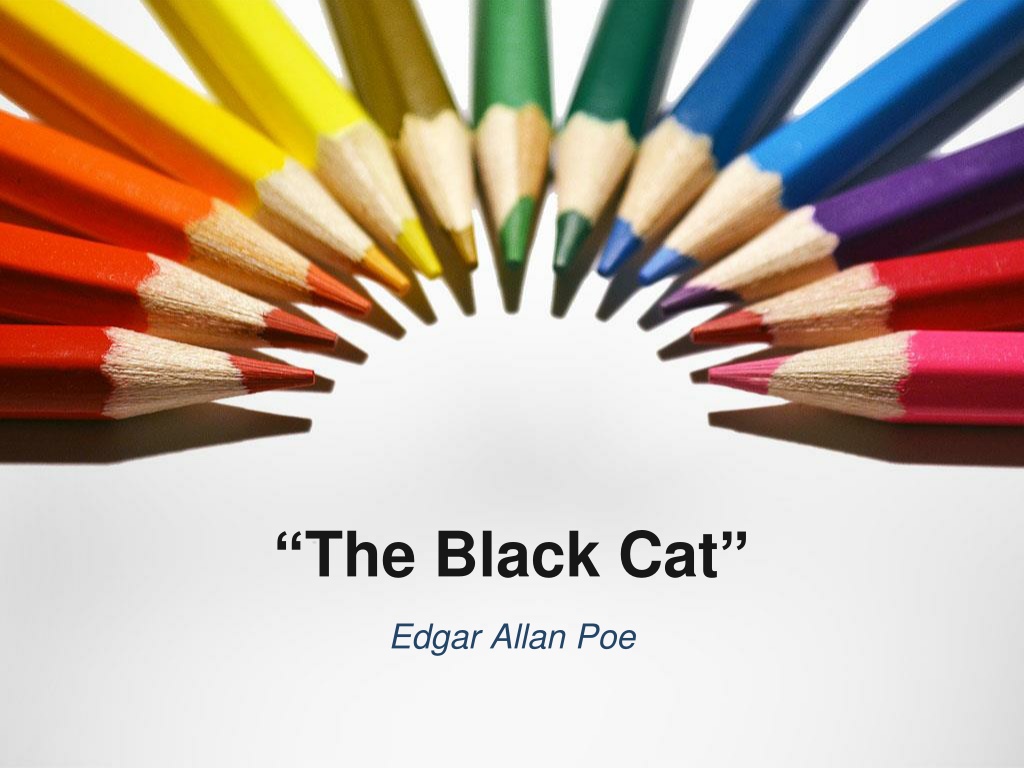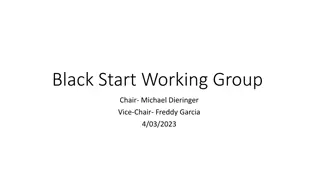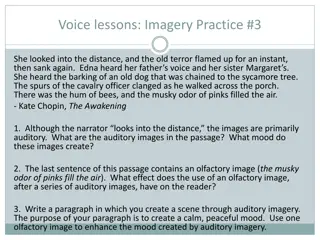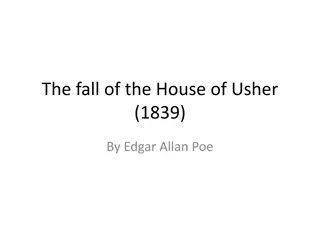Analysis of Edgar Allan Poe's "The Black Cat
The story "The Black Cat" by Edgar Allan Poe delves into the descent of a man into madness, fueled by alcoholism and violence towards animals and his wife. The narrative explores internal conflicts of addiction and external conflicts with animals, leading to a tragic climax where the narrator ends up killing his wife. The resolution comes when the police uncover the horrifying truth behind the walls of the house, revealing the consequences of the narrator's actions.
Download Presentation

Please find below an Image/Link to download the presentation.
The content on the website is provided AS IS for your information and personal use only. It may not be sold, licensed, or shared on other websites without obtaining consent from the author. Download presentation by click this link. If you encounter any issues during the download, it is possible that the publisher has removed the file from their server.
E N D
Presentation Transcript
The Black Cat Edgar Allan Poe
Biographical Notes Poe himself owned a cat at the time that he wrote this short story. He was also a heavy drinker during this period, a (disease) that destroyed his whole life.
Plot Analysis Exposition: The exposition occurs once the flashback has started, the main characters including the narrator himself, his wife, and Pluto are introduced. The exposition also gives insight to their lives, for example the narrator s loves and hobbies are shown.
Rising Action: The narrator kills Pluto and then feels guilty about killing the cat, and gets another one. However, he is still constantly reminded of the cat, and still has mood swings .
Climax: The narrator tries to kill the second cat and ends up killing his wife. He buries her behind the wall.
Falling Action The narrator realizes he cannot find the cat, but doesn't worry too much about it. Later, the police unexpectedly show up to his house. Screaming can be heard coming from inside the walls, and the police break down the wall. Resolution The police find the wife's body and arrest the narrator. It turns out the screaming was coming from the cat, who was also found trapped behind the wall.
Conflicts 1. Internal conflict (Man vs. Addiction): the narrator s struggle with controlling his alcohol. Alcohol becomes a part of him, but it leads to him making decisions he would not necessarily make if he was not intoxicated. 2. External conflict (Man vs. Animal): between narrator and Pluto. The narrator and the cat develop a mutual hatred for each other, which is only solved when one or the others down fall occurs. The narrator never does get his alcoholism under control, and the cat, Pluto, is murdered by the narrator. 3. Man vs. Wife and vs. Police.
Characters The Narrator (protagonist): The narrator in the story The Black Cat is an adult male who enjoys animals and drinking. In addition to this, the narrator is a violent man who often has fits of rage in which he abuses and mistreats his wife and animals. On one particular occasion after coming home highly intoxicated from a bar, the man gouges his cat s eye out with a knife. This shows the narrator s violent, and temperamental personality. However, the narrator also claims that he loves animals which shows his more sympathetic side. Based on this information it is logical to conclude that the narrator is a round character, because he has a variety of traits. The narrator in the story is a dynamic character. In the beginning of the story the man is very fond of animals, and is impartial towards drinking. But by the end, he has grown a hatred for animals, particularly cats, and is a total drunk.
The Wife- The narrators wife is another main character in the story. She is kind, nurturing, and also has a love for animals. Being that she is an animal lover, later in the story she tries to prevent the narrator from harming the animals. The wife is a flat character who does not change in a significant way throughout the story. She is opposed to how the narrator abuses the animals. She reflects good ideals that oppose those of the narrator. Lastly, the wife of the narrator is a flat character. While she has many traits they are very similar and reflect her good heart.
Pluto- Pluto is a black cat, the narrators favorite pet. Pluto is very fond of the narrator and follows him around. However, after the narrator harmed Pluto the cat becomes very belligerent. This proves that Pluto is a dynamic character because he changes throughout the story. It is hard to say whether Pluto is a round character, because he changed which reveals his many traits. Lastly, and most importantly Pluto acts as a foil. Pluto triggers several key events, and he moves the plot along.
The Second Black Cat- The second black cat is very similar to Pluto in the sense that they are both black cats who were the narrator was very fond of, and grew to hate. The second black cat is also loved by the wife of the narrator. Since the cat is not in the story for very long not many traits are revealed, but one important trait is mischievous. This trait makes him a foil in the story, when he triggers the climax.
The Setting The story opens in the cell of a prisoner the day before he is to be executed by hanging. After introducing himself to readers as a man who underwent a horrifying experience, the prisoner writes down the details of this experience, which led to his imprisonment and scheduled execution. The events in his tale are set at his home and in a tavern. Although these events take place over several years, the recounting of these events in writing takes place on a single day in the narrator's prison cell.
Point of View The narrator is obviously deranged, readers learn during his telling of his tale, even though he declares at the outset "mad am I not." He tells readers that excessive drinking helped to bring on his erratic, violent behavior. (It may be that the drinking worsened an existing mental condition.) The narrator tells his story as he sees it from his demented point of view. As in many of his other short stories, Poe does not name the narrator. A possible explanation for this is that the unnamed narrator becomes every human being, thereby enhancing the universality of the short story. In other words, the narrator represents anyone who has ever acted perversely or impulsively and then had to pay for his deed.
Devices Foreshadowing: 1. But tomorrow I die, and today I would unburthen my soul foreshadows that the narrator has something to confess that is weighing on his soul. 2. I grew, day by day, more moody, more irritable, more regardless of the feelings of others. -This foreshadows that his changing personality could have a negative effect on others later in the story. 3. It was a black cat, a very large one, - fully as large as Pluto, and closely resembling him in every aspect but one. Pluto had not a white hair upon any portion of his body; but this cat had a large, although indefinite splotch of white, covering nearly the whole region of the breast. -Later on in the story, the narrator discovers that the white mark resembles the gallows. This foreshadows that someone will be hanged.
Symbolism: 1. The socket of the lost eye -An empty eye socket symbolises revenge in this short story. 2. as if graven in the bas relief upon the white surface, the figure of a gigantic cat. there was a rope upon the animal s neck. -This also symbolises revenge or retribution. After hanging the cat, the narrator s house burned down. only one wall remained standing, and imprinted on the wall was a giant image of a cat with a rope around his neck.
3. The Black Cat - It's more than just the title of the story (it's also an important symbol). Like the bad omen of legend, Pluto (the black cat) leads his owner (the narrator) down the path toward insanity and loss of reason.
Irony: From my infancy I was noted for the docility and humanity of my disposition. This statement is ironic, because in the story the narrator mistreats and slaughters animals. Simile: For what disease is like Alcohol! comparing alcohol to a disease. Alcohol is a recurring theme in Poe's short stories. effects of alcohol, probably because he experienced them firsthand. Poe exemplifies the ill
Themes 1. Perverseness and the Evasion of Responsibility. 2. The Consequences of One-Sided Psychic Development.























